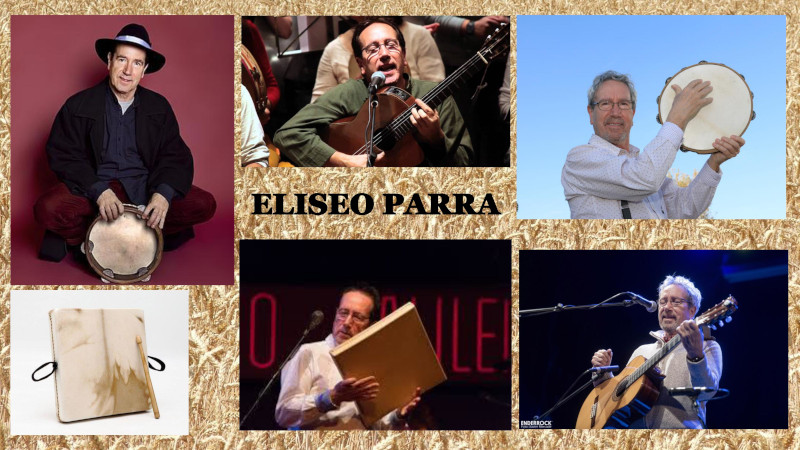

Eliseo Parra is one of the most experienced Spanish folk music artists, and he still maintains a prolific creativity even in these tangled days of Covid-19 in 2021. Born in Sardón del Duero in 1949 (Valladolid, Castilla y León, central north Spain), Eliseo began as a drummer in rock bands in the sixties, then took classes at the municipal conservatory of Barcelona in the early seventies, a jazz musician in that city years later (Blay Tritono, la Rondalla de la Costa), and then in the late seventies and early eighties playing folk & salsa music with singers and bands like: Maria del Mar Bonet, Al Tall, La Sardineta, La Orquestra Plateria, Ovidi Montllor, Gato Pérez, Marina Rossell and Jaume Sisa.
In 1983 Eliseo arrived in Madrid and began to focus on the traditional music of his native region of Castilla, creating the ‘Mosaico’ group, and investigating the repertoire of the folklorist Agapito Marazuela (Segovia, 1891-1983). Let's say that in those years, Eliseo and his generation of folk artists continued to “paddle upstream towards the sources”, while the younger audience somehow flowed downstream enjoying the modern trends of the new wave, punk, techno or heavy metal. However, for the next fifteen years he persisted in learning about the traditional sounds of all of Spain, while creating his own folk music with influences from jazz, rock and Caribbean rhythms. In the mid-1990s, Eliseo Parra released albums such as ‘La boda estorbada’ (Música Sin Fin, 1995), or ‘Arboleras’ Sephardic songs in cooperation with Susana Weich-Shahak and José Manuel Fraile Gil (SAGA, 1996). But it was in the late 1990s, after the new revival of the Spanish ‘Celtic’ and folk music in general, when Eliseo re-emerges for a new generation of trad music fans through his album ‘Tribus Hispanas’ (Música Sin Fin, 1998).
Back in the 80s the younger music fans were being attracted by the urban rock & pop trends of 'La Movida' in big cities like Madrid, Barcelona, Vigo, ... But now, at the beginning of the new millennium, looking back at a life in the countryside and rediscovering the traditions of an aging and disappearing population was seen as a romantic alternative for many fans of novel folk music. Thanks to that hype, Eliseo did not just become a fashionable folk-star and producer for many other new artists all over Spain, he also started in Madrid as a teacher for traditional singing and percussions. Eliseo's success with younger audiences and musicians in that new era of folk music was followed by the CDs: Viva quien sabe querer (Boa Music, 2002), De ayer mañana (World Village–Harmonia Mundi, 2005), Diez (Producciones Mirmidón, 2009), Contradición (Producciones Mirmidón, 2011), Canciones tradicionales riojanas, (2012), and El Man Sur (2015). From 2008 through 2016 Eliseo Parra joined forces with folk band Coetus, the group of percussionists playing traditional music from the Iberian Peninsula.[69]
That apparent resurgence of general interest in folk music that took place since the late 20th century has slowly but steadily diminished to some extent. And now, with the abrupt arrival of the Covid19 pandemic in 2020, the global 'reset' of so many human activities and perspectives in general, has put everything in such a complicated place that it is difficult to know how things will evolve. Nevertheless, in the middle of that critical year Eliseo Parra has returned with the record ‘Cantar y Batir’. Twelve songs, most of them traditional in Spain or written by Eliseo as a musical accompaniment to old folk tales or poems. Although the CD does provide plenty of explanatory texts about the song’s origin and lyrics, Eliseo Parra is the only artist’s name explicitly mentioned.
And that is exactly what you perceive when you listen to all the songs, Eliseo's voice (even in the choral arrangements), and his peculiar way of beating all the different traditional percussion instruments. We have to realize that he recorded this album from March to June 2020, right in the acute phase of the coronavirus pandemic in Spain. The fact that this is practically a one-man effort does not detract from the beauty of the end result at all. The songs 'Granada' & ‘Pena parda’ are a tribute to the women who developed the tradition of the square-frame drum in the town of Peñaparda (Salamanca). "Aksak" emphasizes the importance of unusual metric rhythms that have survived for centuries in the musical traditions of certain places in central and southern Spain. There are songs traditional in many Spanish peninsular regions: ‘Asómate a la ventana’ (Aragón & La rioja), ‘De Luena a Carriedo’ (Cantabria), ‘El borrego’ (Madrid and the provinces of Guadalajara & Cuenca), ‘El boverito’ (Lleida, Catalonia), ‘De corrillo en corrillo’ (Sanabria, province of Zamora, Castilla y León). The final piece is the famous 'Mediterráneo', the 1971 tune by singer-songwriter Joan Manuel Serrat that has been repeatedly hailed as the “best” song in Spain by popular vote across the country in past decades.
Besides his career as a folk musician, Eliseo Parra has developed ethnological research work in cooperation with José Manuel Fraile Gil, and has published the books:
Photo Credits:
(1)-(2) Eliseo Parra (unknown/website);
(3) Coetus (by Karsten Rube).